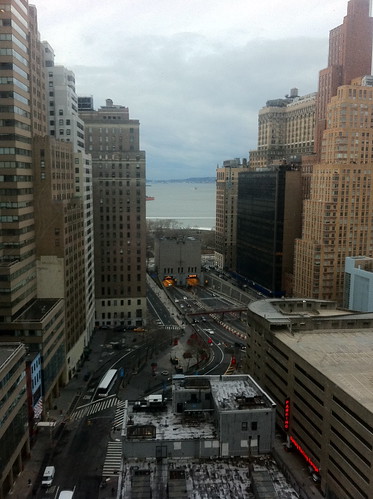
![]() photo credit: gallagher.michaelsean
photo credit: gallagher.michaelsean
The short-term efforts needed to achieve long-term change towards sustainability are to a large extent about creating habits and making sustainable choices natural. In order to get to that point and not fall off the ‘sustainability wagon’ on our way there, we need to address this temporal asymmetry and provide encouragement in the short run. By taking advantage of the agreements and commitments made every day we can ensure we´re not only giving up an easy and convenient way of living but are also getting rewards in the short run.
In the stalemate following the past few years’ climate negotiations, some government and industry players have stopped waiting for an international agreement and made their own moves towards more sustainable practices. One example is the City of New York, which in its PlaNYC has made a commitment to sustainability that spans over the various sectors that the City can influence.
Last year, as part of this commitment, the City of New York together with representatives from the real estate industry developed alease system that will make it easier for commercial landlords and tenants to share costs and benefits of energy efficiency measures. The firstcontract that was signed using the new lease language was between private actors Silverstein Properties and WilmerHale for a floor of the 7 World Trade Center, and the new green leasing system will also be used for all new leases that the City signs as a tenant.
A greenlease addresses the split incentive problem that occurs when one party bears the cost or inconvenience of acting sustainably while the other reaps most of the benefits. In New York, the dominating lease form in the commercial real estate market is the gross lease, which means that energy and other related costs are included in the rent. Under such conditions, the landlord bears the capital cost of improving energy performance, while tenants would benefit from the energy savings. With a green lease however, both the cost of improving energy efficiency and the benefits from such an investment can be shared between the landlord and the tenant under a mutual agreement to act sustainably. And although the green lease developed by the City of New York focuses on energy efficiency improvements, other areas, such as the use of environmentally friendly cleaning products, recycling or limited tenant improvements, can easily be incorporated into the agreement as well.
The green lease is an example of how individual players can make an impact at every level, every time, all the time. For a building that was planned and constructed sustainably (e.g. a LEED certified building), it doesn´t make sense not to also manage, operate and use the building sustainably. A green lease is thus a way to ensure that the sustainability efforts undertaken by the building owner aren’t undermined. However, there is no reason why existing conventional buildings can´t be run in a more sustainable manner as well. When two or more parties enter into an agreement over something, this should be seen as an opportunity to also address sustainability issues.
A green lease is a way to align the interests of tenants and landlords to act more sustainably by giving both parties (economic) incentives to do so. However, there may be difficulties involved with green leases too. One of them is that the parties involved in the agreement have different incentives to point out if the other party isn´t fulfilling its commitment, so this will need to be carefully addressed in the contract. For example, the landlord may have little incentive to point out that the tenant isn’t recycling if she/he is worried how the tenant will act if faced with sanctions. It may therefore be better to have a continuous improvement scale with corresponding rewards, rather than to penalize the other party should it fail to live up to the commitments. This is especially important if we want to ensure that not only the very easy tasks are included in the commitment but also harder goals, that the parties may be unsure of whether they can live up to. We want to provide opportunities to exceed expectations (and to celebrate this when it occurs)! Reward systems have their flaws too but if carefully designed to emphasize that we are all in this together for a greater cause, the chance of success should be greater. Following this, it is also important to engage all actors that will be affected by a green lease. For example, the workers that use the building may be affected differently in their everyday practices than will the management who committed to the sustainability goals, and thus might need education and/or resources to live up to the commitment.
That said, green leases and other contracts that give incentives for all parties to act more sustainably are an untapped opportunity to behave more sustainably, whether in a green building or not. My big idea is to take this opportunity and turn it into something fun; a sustainability challenge that we are all part of and that can be used to acknowledge and reward everyday sustainability practices. When the landlord fulfills his promise to install bicycle storage rooms and showers in the building and the tenants reduce their driving to work as a result – treat all the employees to a bicycle picnic in the nearest park. Or when the employees have reduced the energy consumption in the building – reward them by letting them get off work early on a Friday to re-energize themselves. The small gestures count and should be acknowledged and celebrated, only then can we build sustainable practices into our everyday life. By taking advantage of the long and short term contracts signed every day we can help each other remember and achieve this.
